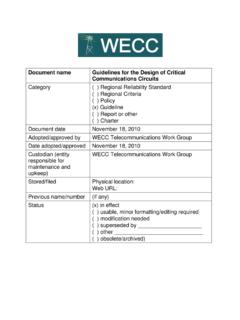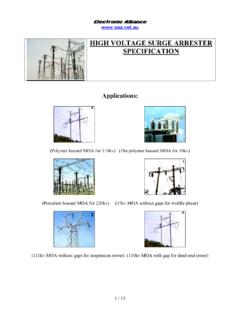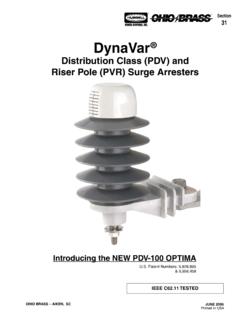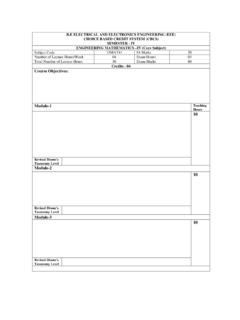Transcription of NEUTRAL EARTHING APPLICATION GUIDE …
1 NEUTRAL EARTHING RESISTORS or REACTORS (including resonant reactance EARTHING ) NZCCPTS Issue 3 September 2010 APPLICATION GUIDE The New Zealand Committee for the Co-ordination of Power and Telecommunication Systems Inc. (NZCCPTS) The New Zealand Committee for the Co-ordination of Power and Telecommunication Systems was established in 1985 following the increasing need to implement efficient cost-effective measures for the limitation of hazard and interference to power and Telecommunications Systems and Personnel. Such measures not only require the determination of optimum engineering solutions consistent with minimum national cost, but also necessitate clear GUIDE -lines covering the equitable allocation of responsibilities during all work phases from planning through to in-service operation.
2 The objective of the New Zealand Committee for the Co-ordination of power and Telecommunication Systems is to meet these needs and, by means of publications and seminars, promote a greater awareness and understanding of the action that must be taken to ensure that Power and Telecommunication Systems coexist satisfactorily. Membership of the Committee and its Working parties currently comprises representatives for each of the following organizations: Transpower New Zealand Ltd. Telecom New Zealand Ltd. Electricity Engineers' Association of New Zealand Inc. KiwiRail (NZ Railways Corporation) Energy Safety, Ministry of Economic Development For further information concerning this Committee and its published guides, contact: The Secretary Secretary as at September 2010 NZCCPTS Michael O'Brien 3 Moehau Grove Consulting Engineer Trentham Ph: 0-4-528 9117 Upper Hutt 5018 Fax: 0-4-528 9116 NEW ZEALAND Email: APPLICATION GUIDE FOR NEUTRAL EARTHING RESISTORS / REACTORS (including resonant reactance EARTHING ) for the control of earth fault currents in power systems operating at 33kV or less Published and issued by: The New Zealand Committee for the Co-ordination of Power and Telecommunication Systems Inc.
3 (NZCCPTS) 3 Moehau Grove Trentham Upper Hutt 5018 NEW ZEALAND Issue 3 September 2010 ISBN 978-0-473-17117-9 Foreword The GUIDE sets out recommended practices which should be used for the planning, design and co-ordination of Power Systems, when it is desired to install NEUTRAL EARTHING Resistors/Reactors (NER s) (including resonant reactances) to limit the flow of current during a fault between phase and earth. The GUIDE focuses on the use of NER s to control the level of Induction or Earth Potential Rise (EPR) hazard to telecommunication users, staff and plant. However, the principles apply to the installation of NER s for any purpose, and consideration is given to industrial usage. Acknowledgements Section is reprinted from IEC71-2 Insulation Co-ordination - Part 2 : APPLICATION GUIDE , Annex B with permission of Standards New Zealand. Copyright of this material remains the property of the International Electrotechnical Commission.
4 NZCCPTS is also indebted to the Electricity Engineers' Association of New Zealand, Telecom New Zealand Limited, Tranz Rail Limited, and the Energy Safety Service Group, Ministry of Consumer Affairs, for their contributions in the formation of this GUIDE . NZCCPTS also records the kind permission of the authors for the papers included as appendices E, F, and G, together with the permission of the Electricity Engineers Association of New Zealand. Appendices were initially published as EEA Conference papers. The information contained in this booklet has been compiled by the NZCCPTS for the use of its members from sources believed to be reliable, but neither the NZCCPTS nor any of the contributors to this booklet (whether or not employed by NZCCPTS) undertake any responsibility for any mis-statement of information in the booklet, and readers should rely on their own judgement or, if in doubt, seek expert advice on the APPLICATION of the guidelines to work being carried out.
5 Comments for revision of this GUIDE are welcomed. Any comments or information that may be useful for inclusion in future issues should be forward to: Michael O'Brien Secretary Ph: 0-4-528 9117 NZCCPTS Fax: 0-4-528 9116 3 Moehau Grove Email: Trentham Upper Hutt 5018 NEW ZEALAND A brief description of the objectives and organization of the New Zealand Committee for the Co-ordination of Power and Telecommunication Systems Inc. is printed inside the cover of this publication. Document History Issue No. Publication Date 1 November 1994 2 August 2002 3 September 2010 Contents 1 Introduction 1 Scope 1 Background 1 Induction (Magnetic Coupling) 1 Capacitive (Electric Coupling) 1 Direct Contact 2 Earth Potential Rise (EPR)
6 2 Hazard to Telecommunication Networks 3 Methods of Mitigating EPR and Induction Hazard to Telecommunication Networks 3 Telecommunication System Isolation 3 Increase the Separation between the Power and Telecommunication Plant 3 Install Gaseous Arresters in Telecommunication Plant 3 Shielding of Telecommunication Conductors 4 Add Earth Return Conductor 4 Lower the Resistance of the Power EARTHING System 4 Increase Zero Sequence Impedance using a NEUTRAL Impedance 5 2 Definition of Terms and Drawing Symbols 6 3 Devices and Methods of EARTHING 8 Overseas and NZ Practice 8 United Kingdom (UK) Practices 8 European Practices 9 Australian Practices 9 Solid EARTHING 9 Unearthed Systems 10 Resonant EARTHING (Petersen Coils, Arc Suppression Coils, Earth Fault Neutraliser EARTHING )
7 10 Resistive/Reactive EARTHING 10 Reduction of Earth Fault Current 11 Use of EARTHING Transformers 11 4 Current Considerations 11 Source Fault Levels 11 Earth Fault Current Path 11 effect of an NER on EPR 13 effect of an NER on Magnetically Induced Voltages 13 5 Voltage Considerations 15 Introduction 15 Lightning 15 Switching Surges 15 Electrostatic 15 Contact with Higher Voltage System 15 line -to-Earth Faults 16 Resonant Conditions 16 Re-striking Earth Faults 16 The effect of EARTHING Methods on System Voltages 16 EARTHING the System NEUTRAL 16 Effectively Earthed System 16 Reactance-Earthed System 17 Resonant-Earthed System 17 Resistance-Earthed System 17 Unearthed System 18 Transient Effects 18 APPLICATION in New Zealand 23 Introduction 24 Changes to Network Protection 24 Protection of the NER and associated Transformer 26 NER 26 Transformer Protection 26 7 Design Criteria and Device Selection 28 Introduction 28 Existing System Components 28 General 28 Transformers 28 Switchgear 30 Cables 31 Impedance Value 31 Impedance Type 31 Resistors
8 31 Reactors 32 Design for Reliability 33 Comparative Costs 33 8 Electrical Connections for NERs 37 9 Installation 44 Retrofit of an NER 44 New Installations incorporating NER's 44 10 Commissioning 45 11 Routine Maintenance 45 12 General AC Network Benefits of Installing NER's 45 13 The use of NERs in Mining and Industrial applications 46 General Mining applications 46 Underground Mining Sites 47 NER s in other Industries 47 14 References 48 Appendix A Time Domain Study of EPR 49 Appendix B Investigations into EPR Transient Phenomena 52 Appendix C Typical Maintenance Schedule for a Liquid EARTHING Resistor 53 Appendix D Indicative Costs for the Installation of Stainless Steel Resistor NER s 56 Appendix E Results of a 10 Year Study of Earth Faults on a Combined Urban/Rural 33/11 kV Substation Equipped with NER 59 Appendix F The first APPLICATION of resonant EARTHING with residual compensation to a New Zealand distribution network 65 Appendix G Resonant EARTHING - Advantages and Disadvantages.
9 Why Do We Not Use It in New Zealand? 84 1 1 Introduction Scope This GUIDE describes the issues which should be considered when it is desired to install NEUTRAL EARTHING resistors or reactors (NER's) (including resonant reactances) on power systems having a phase to earth voltage less than to limit the magnitude of phase to earth fault currents, for the purpose of controlling the EPR and induced voltages on nearby telecommunication systems to below hazard levels. Nothing in this GUIDE shall relieve all those who own and operate electric power lines from complying with the provisions of the Electricity Regulations or any other statutory Act or Regulation. The GUIDE does not describe all the conditions to be met for systems operating at higher phase to earth voltages than , because such systems may incorporate plant with graded insulation or may be designed for less than the basic insulation levels (BIL) needed when using an NER.
10 The effect of insulation ageing and consequent reduction of basic insulation level has not been taken into account in this GUIDE . Background There have been many instances of telecommunication system damage due to excessive impressed current and voltage from the nearby power system (usually during earth faults on the power system). These present a hazard to telecommunication system users and staff, as well as telecommunication system plant. The mechanisms through which this hazard or damage arises are: Induction (Magnetic Coupling) Capacitive (Electric Coupling) Direct Contact Earth Potential Rise Induction (Magnetic Coupling) When an earth fault occurs in a power supply system, the net unbalanced fault current that flows in the power line (and returns via earth) creates a magnetic field. If a telecommunication cable runs parallel to the power line for a sufficient length, a high voltage may be induced by this magnetic field onto any metallic conductors in the telecommunication cable.



